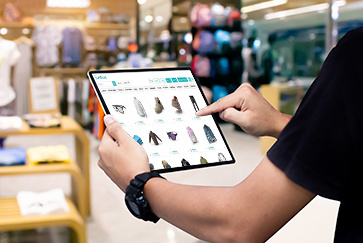Share this
The RFP Playbook 3: A Blueprint for PLM Success
by Surefront on Dec 13, 2024 12:37:35 PM
Home > Blog > A Blueprint for PLM Success
Table of Contents
- What is PLM?
- The Four Phases of PLM
- Why PLM is Essential for Modern Business
- The Role of an RFP in Choosing PLM Software
- Quick Tips for Creating an RFP
- Further Reading
Setting the Stage for PLM Success
Crafting the perfect Request for Proposal (RFP) is the cornerstone of finding the right Product Lifecycle Management (PLM) software for your business. But how do you know if your organization is truly ready to take this step? Identifying key signs of readiness and pairing them with an expertly crafted RFP ensures that you’re equipped to select the ideal solution confidently.
This blog combines the foundational strategies for building your RFP with actionable insights into recognizing when your business is ready for PLM. Together, these tools will help you streamline processes, improve collaboration, and ensure the success of your product lifecycle management efforts.
Part 1: The Building Blocks of a Winning RFP
Creating an RFP for PLM software is about clarity and precision. A well-crafted RFP doesn’t just ask vendors about features; it outlines your business needs, challenges, and goals. Here’s how to structure your RFP for maximum success:
1. Define Your Needs and Challenges
Every business has unique pain points that PLM software can address. Start by asking questions like:
-
What’s slowing down our product development processes?
-
Are miscommunications leading to costly errors?
-
Do we need better collaboration across teams and external partners?
Example: A global retailer faced significant delays due to disjointed workflows. By focusing their RFP on collaboration and workflow integration, they selected a PLM system that reduced their time-to-market by 25%.
2. Prioritize Features That Align With Your Goals
Some essential features to consider include:
-
Centralized data management
-
Real-time collaboration tools
-
Customizable workflows
-
Scalability for future growth
3. Ask Targeted Questions
Your RFP should probe vendors on critical aspects like:
-
How intuitive is your user interface?
-
What training and support are included?
-
Can the solution integrate with our existing tools (e.g., ERP, PIM)?

Part 2: Recognizing the 5 Signs You Need PLM Software
Once you’ve started building your RFP, the next step is understanding whether your organization is ready to adopt PLM. Here are five unmistakable signs:
1. You Rely on Outdated Tools
Are your teams juggling spreadsheets, emails, and PDFs to manage product data? These outdated tools create silos and errors that cost time and money.
 |
IKEA modernized its processes by replacing spreadsheets with a centralized PLM platform, reducing development timelines by 18%. |
Real-World Insight:
2. Your Teams Are Overwhelmed
If teams are constantly firefighting rather than innovating, it’s a sign you need PLM. Automating repetitive tasks frees up resources for strategic initiatives.
3. Your Data Is Trapped in Silos
Disconnected systems make it difficult to access or share critical information. PLM software centralizes data, ensuring everyone has real-time access.
4. You Lack Transparency
Without visibility into your workflows, it’s hard to pinpoint inefficiencies or bottlenecks. PLM provides a clear picture of your product lifecycle, from ideation to market.
5. Your Current Processes Can’t Scale
As your business grows, so do your product management challenges. A scalable PLM solution ensures you’re ready for expansion.
 |
Patagonia leveraged a retail-focused PLM system to streamline product design and sourcing for their eco-friendly lines, enabling sustainable scaling. |
Part 3: Crafting a Unified Approach
By combining the strategies for building an RFP with an awareness of readiness indicators, you position your business to make the right choice confidently. Remember:
-
Start with a clear understanding of your needs and challenges.
-
Use your RFP to evaluate vendors on usability, scalability, and support.
-
Recognize the signs that your current tools and processes are holding you back.
The 4 Phases of PLM
PLM breaks down the lifecycle of a product into four core stages. Each stage involves complex workflows and collaboration among multiple stakeholders, making a unified system essential.

 |
Big Brand Example: Nike’s PLM TransformationTo stay ahead in the fast-paced athletic wear industry, Nike adopted a custom PLM system to centralize data and improve global collaboration. By aligning designers, manufacturers, and marketing teams on a single platform, Nike reduced their product development cycle by 30% and increased their ability to launch trend-responsive collections. |
Why PLM is Essential for Modern Businesses
In industries like fashion, retail, and consumer goods, success depends on speed, efficiency, and innovation. PLM is no longer a luxury; it’s a necessity.
1. Keeping Pace with Trends
In markets driven by fast-changing trends, delays in product development can mean missed opportunities. PLM accelerates time-to-market, ensuring businesses can capitalize on emerging demand.
2. Managing Complex Supply Chains
With global suppliers, manufacturers, and distributors in play, managing product data across the supply chain can be chaotic. PLM centralizes this information, reducing miscommunication and errors.
3. Meeting Customer Expectations
Consumers expect high-quality products delivered quickly. PLM improves product quality by identifying and addressing issues early in the process.
Big Brand Example: Adidas
Adidas implemented PLM to improve collaboration between their design and production teams. By integrating workflows and automating approvals, the company launched seasonal collections 20% faster, staying ahead of competitors.
The Role of an RFP in Choosing PLM Software
Selecting the right PLM software is a significant decision, and an RFP ensures you approach it strategically.
What is an RFP?
An RFP (Request for Proposal) is a document that outlines your business needs, goals, and requirements, inviting vendors to propose solutions that meet these criteria.
How an RFP Helps:
- Clarifies Needs: Forces you to identify your challenges and prioritize features.
- Streamlines Evaluation: Provides a standardized way to compare vendors.
- Reduces Risk: Ensures you choose a system aligned with your goals, avoiding costly missteps.
Key Questions to Include in Your RFP:
- How does your software handle data centralization?
- What collaboration tools are included for internal and external teams?
- Can the system scale to accommodate future growth?
- What integrations are available with ERP and PIM systems?
- What support do you offer during onboarding and implementation?
Quick Tips for Crafting an Effective RFP
- Engage Stakeholders: Involve representatives from all departments, including design, marketing, and supply chain.
- Be Specific: Detail your pain points and must-have features.
- Request Demos: Ask vendors to demonstrate how their system addresses your unique challenges.
- Use a Template: Surefront offers a free RFP template to simplify the process.

Conclusion
Building the right RFP and understanding your readiness for PLM adoption go hand in hand. Together, they ensure that your investment in PLM software delivers real results—from faster time-to-market to improved collaboration and scalability.
Ready to start? Download our free RFP template today and take the first step toward a streamlined, successful PLM journey!

The RFP Playbook 1: Selecting the Best PLM
The RFP Playbook 2: Best PLM Step-by-Step
The RFP Playbook 3: A Blueprint for PLM Success
Further Reading

PLM vs PIM: Which Do You Need?

What are Tech Packs?

The Ultimate Guide to a Perfect Line Sheet

The Complete Guide to Product Development and Merchandising
Surefront is flexible. It works seamlessly when the buyer and vendor are meeting in-person or discussing products remotely.
You don’t want your data to be siloed. Your company’s CRM, PIM and PLM solutions shouldn’t operate in a vacuum, either. Surefront is a unified product collaboration platform to power growth and ROI. Our patented PIM, CRM, and PLM solutions streamline the omni channel sales, merchandising and product development processes. By combining these essential functionalities, Surefront creates a single source of truth throughout your product lifecycle, sales and listing processes.
The results? Up to 150% more revenue per employee and a 40% shorter product development cycle is just the beginning. Try our 10x ROI calculator to see your company’s potential profits. Or, skip the noise and book a custom demo with one of our unified product collaboration management experts today. The retail industry evolves quickly and has a lot of moving parts. We do all of the research, so you don’t have to. Stay ahead of market fluctuations, trends and new features by subscribing to our Unified Product Collaboration Management Blog.
References
- Surefront Surefront Blog
- Deloitte: The Future of Product Lifecycle Management
- Forrester Research: The ROI of PLM Software
- Forbes: Nike PLM Adoption
- Gartner: Crafting Effective RFPs for Business Software
- TechTarget: Product Lifecycle Management Overview
Share this
- PLM Software (32)
- PIM Software (27)
- Trending Topics (20)
- Apparel & Fashion (14)
- CRM Software (12)
- Merchandising (5)
- Success Stories (5)
- Sustainability (5)
- Tech Packs (5)
- Catalog Management (4)
- Luxury Goods & Jewelry (4)
- Product Development (4)
- Retail (4)
- Supply Chain (4)
- Data Import (3)
- Home Furnishings (3)
- Line Sheet (3)
- PLM Implementation (3)
- PLM RFP (3)
- Wholesale (3)
- Category Management (2)
- Consumer Packaged Goods (CPG) (2)
- Cosmetics (2)
- Data Export (2)
- Health & Beauty (2)
- Industry Events (2)
- RFQ & Quote Management (2)
- Consumer Electronics (1)
- Import & Export (1)
- Inventory Management (1)
- Pet Stores (1)
- Purchase Orders (1)
- Report Builder (1)
- Textiles & Raw Materials (1)
- Unified Solution (1)
- Vendor Management (1)
- White Paper or Case Study (1)
- December 2024 (5)
- November 2024 (3)
- October 2024 (5)
- September 2024 (6)
- August 2024 (2)
- July 2024 (1)
- June 2024 (3)
- May 2024 (4)
- April 2024 (5)
- March 2024 (3)
- February 2024 (2)
- December 2023 (4)
- September 2023 (2)
- August 2023 (5)
- July 2023 (3)
- June 2023 (2)
- May 2023 (2)
- April 2023 (4)
- March 2023 (5)
- February 2023 (3)
- January 2023 (5)
- December 2022 (4)
- November 2022 (3)
- October 2022 (4)
- September 2022 (5)
- August 2022 (4)
- July 2022 (3)
- June 2022 (1)
- May 2022 (1)
- February 2022 (1)
- January 2022 (1)
- September 2021 (1)
- May 2021 (1)
- April 2021 (1)
- February 2021 (1)
- December 2020 (1)
- May 2020 (1)